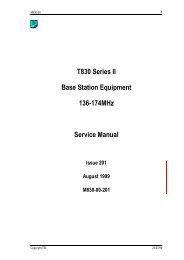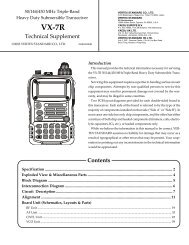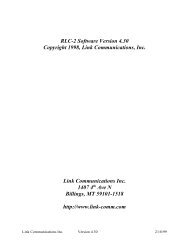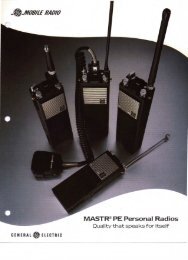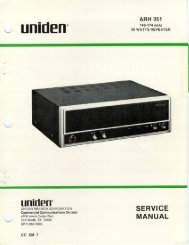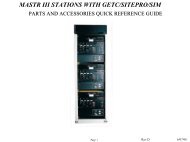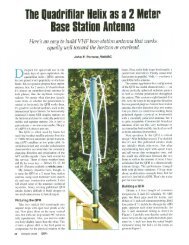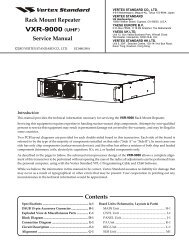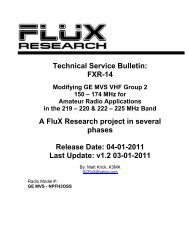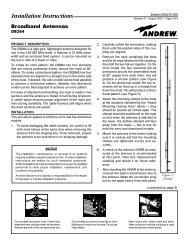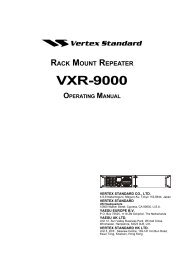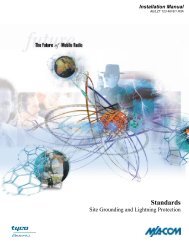VXR-7000 CE27 EEPROM Programming Software Reference Manual
VXR-7000 CE27 EEPROM Programming Software Reference Manual
VXR-7000 CE27 EEPROM Programming Software Reference Manual
You also want an ePaper? Increase the reach of your titles
YUMPU automatically turns print PDFs into web optimized ePapers that Google loves.
<strong>CE27</strong> <strong>EEPROM</strong> PROGRAMMING SOFTWARE REFERENCE MANUAL<br />
<strong>CE27</strong> <strong>EEPROM</strong> PROGRAMMING SOFTWARE<br />
REFERENCE MANUAL<br />
The <strong>CE27</strong> is used to program the <strong>VXR</strong>-<strong>7000</strong> Desktop Repeater. With<br />
the <strong>CE27</strong> <strong>Programming</strong> <strong>Software</strong>, you can quickly and easily program<br />
the Vertex <strong>VXR</strong>-<strong>7000</strong> repeater’s channels and configuration from your<br />
personal computer. In the event of an accidental memory failure, repeater<br />
memory and configuration data may be re-loaded in a matter of<br />
minutes.<br />
VERTEX STANDARD CO., LTD.<br />
4-8-8 Nakameguro, Meguro-Ku, Tokyo 153-8644, Japan<br />
VERTEX STANDARD<br />
US Headquarters<br />
17210 Edwards Rd., Cerritos, CA 90703, U.S.A.<br />
International Division<br />
8350 N.W. 52nd Terrace, Suite 201, Miami, FL 33166, U.S.A.<br />
YAESU EUROPE B.V.<br />
P.O. Box 75525, 1118 ZN Schiphol, The Netherlands<br />
YAESU UK LTD.<br />
Unit 12, Sun Valley Business Park, Winnall Close<br />
Winchester, Hampshire, SO23 0LB, U.K.<br />
VERTEX STANDARD HK LTD.<br />
Unit 5, 20/F., Seaview Centre, 139-141 Hoi Bun Road,<br />
Kwun Tong, Kowloon, Hong Kong
<strong>CE27</strong> <strong>EEPROM</strong> PROGRAMMING SOFTWARE REFERENCE MANUAL<br />
Important Note!<br />
Do not work directly with the <strong>CE27</strong> programming diskette. Make a copy of it<br />
and use the copy when programming the <strong>VXR</strong>-<strong>7000</strong>. Keep it and the original<br />
distribution diskette in a safe place in case you need to make another copy of it<br />
later.
<strong>CE27</strong> <strong>EEPROM</strong> PROGRAMMING SOFTWARE REFERENCE MANUAL<br />
INSTALLING THE PROGRAM<br />
The <strong>CE27</strong> programming diskette contains the following files:<br />
r <strong>CE27</strong>.EXE<br />
r <strong>CE27</strong>.HLP<br />
Before connecting the <strong>VXR</strong>-<strong>7000</strong> for programming, turn off both the computer and the<br />
<strong>VXR</strong>-<strong>7000</strong>. Now connect the VPL-1 Connection Cable to the computer’s serial port and<br />
the <strong>VXR</strong>-<strong>7000</strong> front panel MIC jack.<br />
Then it will be safe to restart the computer; turning off the equipment during interconnection<br />
avoids the potential for damage to the electronics caused by voltage spikes.<br />
Insert the distribution diskette into your 3½” drive (after booting DOS), and make a copy<br />
of the diskette; use the distribution diskette for archive purposes, and use the disk copy for<br />
programming.<br />
Place the <strong>CE27</strong> (copy) diskette into your 3½” drive (usually “Drive A”), and log onto this<br />
drive by typing “A: [ENTER]”, then load the contents of the <strong>CE27</strong> diskette into a directory<br />
named <strong>CE27</strong>, using the COPY command (e.g. “COPY A:Þ.Þ C:\<strong>CE27</strong>”).<br />
Now type “<strong>CE27</strong> [ENTER]” to start the program. The introductory screen will appear, and<br />
you may press any key to enter the main screen.<br />
Choose the “Help” contents option ([F1] key) from the program’s Menu for assistance<br />
with channel programming or setting of parameters.<br />
<strong>VXR</strong>-<strong>7000</strong> <strong>Programming</strong> Setup<br />
Important Note!<br />
Before creating the programming data via the <strong>CE27</strong> programming software,<br />
upload the current hardware environment data from the repeater by [F5]<br />
(ReadRom) key, first time. See page 9 for details regarding the [F5] (ReadRom)<br />
key.<br />
1
<strong>CE27</strong> <strong>EEPROM</strong> PROGRAMMING SOFTWARE REFERENCE MANUAL<br />
THE CHANNEL PROGRAMMING SCREEN<br />
The main Screen consists of four major sections: Common Data Items, Key Help, Channel<br />
Data, and Function Key Selections.<br />
Common Data Items<br />
At the upper left are found the Edit, Band, Serial No. and COM Port items, which are<br />
“Common” Data items that you may need to refer to when making entries in the Channel<br />
Data.<br />
The Edit entry is the name of the current data file being edited, if any. If no file has been<br />
read (via the [F3] key, “DiskLoad” function) or Saved (via the [F4] key, “DiskSave”<br />
function), “noname.rpt” is displayed here.<br />
The Band entry indicates the operating frequency band of your repeater. “VHF” or “UHF”<br />
are automatically set and should not be altered unless you change repeaters.<br />
The Serial No. entry indicates your repeater’s product identification number. The product<br />
number is entered from the “HARDWARE ENVIRONMENT” window. See page 19 for details.<br />
The COM Port entry indicates which Serial Port on your computer is to be connected to<br />
the VPL-1 Control Cable.<br />
Common Data cannot be changed from this screen.<br />
<strong>CE27</strong> Main Screen (Left)<br />
2
<strong>CE27</strong> <strong>EEPROM</strong> PROGRAMMING SOFTWARE REFERENCE MANUAL<br />
THE CHANNEL PROGRAMMING SCREEN<br />
Key Help Box<br />
The Key Help box at the upper right indicates the keyboard keys that can be used to edit<br />
data at any given moment. The contents of this box change according to the location of the<br />
cursor in the Channel Data table, so you will need to watch this box while becoming familiar<br />
with the channel editor. For example, when the program first starts, you will see “Rx<br />
Freq.” (Receiving Frequency) field, which indicates that you can enter the receiving frequency<br />
into the current channel from the [0] ~ [9] and [•] keys on the PC’s keyboard.<br />
You can press the [F1] key for more detailed help on the functions of particular keys in the<br />
current cursor field. Of course, you can always use the cursor keys to select another field<br />
(unless you are in the middle of entering new field data).<br />
Channel Data Table<br />
The largest section of the screen is the Channel Data table. Press the [UP], [DOWN], [LEFT]<br />
and [RIGHT] arrow keys on the PC’s keyboard to move the cursor around the table (you<br />
may have to press the [NUM LOCK] key to switch the keypad from numeric to cursor movement<br />
mode if your keyboard does not have separate cursor keys). Each line in the editing<br />
table represents one channel, with the columns indicating the current setting of each parameter<br />
that can be set for that channel. Hyphens indicate that a parameter is not currently<br />
being used. If all of the fields on a line are hyphens, the channel is currently blanked<br />
(hidden from use).<br />
Note that, to access the right-most columns (“Action Mode,” “Tx Freq.,” “Encoders<br />
CTCSS” etc.), just move the cursor to the right from the right-most edge of the screen. The<br />
table will scroll sideways to reveal the additional columns.<br />
<strong>CE27</strong> Main Screen (Scrolled Right)<br />
3
<strong>CE27</strong> <strong>EEPROM</strong> PROGRAMMING SOFTWARE REFERENCE MANUAL<br />
THE CHANNEL PROGRAMMING SCREEN<br />
Ch: Channel Number.<br />
This 2-digit number (“01” ~ “16”) is used to identify the channel. Channel numbers<br />
occur in sequence, and their order can not be changed.<br />
Rx Freq.: Edit Receive (or simplex) Frequency.<br />
Use the [0] ~ [9] keys to enter the desired channel frequency directly, and press the<br />
[ENTER] key.<br />
Decoders CTCSS: Toggle CTCSS Decoder ON/OFF, set CTCSS Frequency.<br />
Press the [SPACE] bar to toggle the CTCSS Decoder “on” or<br />
“off,” or press the [ENTER] key to display the “TONE SELECT”<br />
window, from which you may select a CTCSS frequency using<br />
the [ARROW] key; press [ENTER] again to accept the selected<br />
tone, or press [ESC] key to cancel.<br />
Decoders DCS: Toggle DCS Decoder ON/OFF, set DCS Code number.<br />
Press the [SPACE] bar to toggle the DCS Decoder “on”<br />
or “off,” or press the [ENTER] key to display the “CODE<br />
SELECT” window, from which you may select a DCS<br />
code using the [ARROW] key; press [ENTER] again to<br />
accept the selected code, or press [ESC] key to cancel.<br />
W/N: Wide/Narrow Channel Spacing.<br />
This function selects the channel spacing environment in which the <strong>VXR</strong>-<strong>7000</strong> operates.<br />
W (Wide) = 25 kHz Channel Spacing, ±5 kHz Deviation.<br />
N (Narrow) = 12.5 kHz Channel Spacing, ±2.5 kHz Deviation.<br />
Press the [SPACE] bar to select the desired channel spacing environment.<br />
Clk Sft: Enable/disable the CPU Clock Shift.<br />
This function is only used to move a spurious response “birdie” should it fall on a<br />
current frequency.<br />
Press the [SPACE] bar to toggle “yes” or “no.”<br />
NSQ Mode: Noise Squelch Mode.<br />
This command selects the manner of setting of the Squelch threshold level.<br />
User = The squelch threshold level is fixed via the NSQ Lv parameter (below)<br />
(NSQ Lv: 0 [min.] ~ 255 [max.]).<br />
Prpgm = The squelch threshold level is fixed to the programmed values which is<br />
determined via the “HARDWARE ENVIRONMENT” window; see page 19 for<br />
details.<br />
Press the [SPACE] bar to select the desired NSQ Mode.<br />
4
<strong>CE27</strong> <strong>EEPROM</strong> PROGRAMMING SOFTWARE REFERENCE MANUAL<br />
THE CHANNEL PROGRAMMING SCREEN<br />
NSQ Lv: Noise Squelch threshold level.<br />
Use the [0] ~ [9] keys to enter the desired Squelch threshold level directly, and press<br />
the [ENTER] key. Available Values are 0 (min.) ~ 255 (max.).<br />
Court Blip: Courtesy Blip.<br />
When this parameter select “on,” this function causes the <strong>VXR</strong>-<strong>7000</strong> to send out a<br />
“blip” on the portable/mobile radio is frequency each time the portable radio is unkeyed.<br />
This provides audible confirmation to the user that the <strong>VXR</strong>-<strong>7000</strong> was able to receive<br />
the transmission from the portable/mobile.<br />
Press the [SPACE] bar to toggle “on” or “off.”<br />
Rev Bst: Reverse Burst.<br />
When this parameter is set to “on,” the CTCSS tone’s phase will be inverted just before<br />
the repeater returns to receive.<br />
Press the [SPACE] bar to toggle “on” or “off.”<br />
DSC Typ: DCS Format.<br />
This command is effective only when DCS is chosen for squelch control.<br />
A = “Normal” DCS<br />
B = “Inverted” (complement) DCS<br />
Press the [SPACE] bar to select the desired DCS Type.<br />
DDec Type: DCS Decoder Type.<br />
This command selects the manner in which DCS is to be decoded.<br />
Fixed = Decodes only the type selected in the above parameter (DCS Typ: Normal<br />
or Inverted).<br />
Auto = Both types (Normal and Inverted) will be decoded.<br />
Press the [SPACE] bar to select the desired DCS Decoder Mode.<br />
Multi Tone: Enable/disable the Multi Tone Operation.<br />
Press the [SPACE] bar to toggle the Multi Tone Operation between selections “yes”<br />
and “no.”<br />
Press the [ENTER] key to display the “MULTI TONE SELECT” window, from which you<br />
may select a CTCSS tone or DCS code; move the cursor to the appropriate field you<br />
using the [ARROW] key, then press the [ENTER] key to open the “TONE SELECT” or<br />
“CODE SELECT” window. Now select the desired CTCSS<br />
tone or DCS code using the [ARROW] key, then press the<br />
[ENTER] key again to accept the selected tone or code, or<br />
press [ESC] key to cancel.<br />
You may set as many as 16 CTCSS tones and/or DCS codes.<br />
Note that, if you do not yet program a CTCSS tone or DCS code in the “MULTI TONE<br />
5
<strong>CE27</strong> <strong>EEPROM</strong> PROGRAMMING SOFTWARE REFERENCE MANUAL<br />
THE CHANNEL PROGRAMMING SCREEN<br />
SELECT” window (when the “MULTI TONE SELECT” window data is not programmed),<br />
press the [SPACE] bar to display the “MULTI TONE SELECT” window directly.<br />
CWID ANI/ENI: Select the Identifier mode.<br />
Press the [SPACE] bar to toggle the selections “CW ID,” “ANI/ENI,” or “off.” To select<br />
this feature to the “CW ID” or “ANI/ENI,” the “CW ID” parameter must be enabled via<br />
the “EDIT COMMON DATA” window; see page 13 for details.<br />
Action Mode: Select the repeater operation mode.<br />
Press the [SPACE] bar to toggle between “Duplex” operation or “Simplex” operation.<br />
Tx Freq.: Edit Transmit Frequency.<br />
Use the [0] ~ [9] keys to enter the desired channel frequency directly, and press the<br />
[ENTER] key.<br />
Encoders CTCSS: Toggle CTCSS Encoder ON/OFF, set CTCSS Frequency.<br />
Press the [SPACE] bar to toggle the CTCSS Encoder “on” or<br />
“off,” or press [ENTER] key to display the “TONE SELECT” window,<br />
from which you may select a CTCSS frequency using the<br />
[ARROW] key; press [ENTER] again to accept the selected tone,<br />
or press the [ESC] key to cancel.<br />
Encoders DCS: Toggle DCS Encoder ON/OFF, set DCS Code #.<br />
Press the [SPACE] bar to toggle the DCS Encoder “on”<br />
or “off,” or press [ENTER] key to display the “CODE SE-<br />
LECT” window, from which you may select a DCS code<br />
using the [ARROW] key; press [ENTER] again to accept<br />
the selected code, or press the [ESC] key to cancel.<br />
Base TOT: Enable/disable the Time-Out Timer while in the “BASE” station mode.<br />
Press the [SPACE] bar to toggle the TOT feature selections “yes” or “no.”<br />
The TOT time is determined via the “EDIT COMMON DATA” window; see page 12 for<br />
details.<br />
Base Guard: Enable/disable the Base Guard Feature.<br />
When this parameter is set to “yes,” the transmitter will be inhibited a desired number<br />
of seconds before the repeater is unkeyed while operating in the “BASE” mode.<br />
The inhibit time is determined via the “EDIT COMMON DATA” window; see page 12 for<br />
details.<br />
6
<strong>CE27</strong> <strong>EEPROM</strong> PROGRAMMING SOFTWARE REFERENCE MANUAL<br />
THE CHANNEL PROGRAMMING SCREEN<br />
LOUT: Select the Lock Out Feature’s mode.<br />
Press the [SPACE] bar to toggle the Lock Out Feature between “BCLO,” “BTLO,” or<br />
“off,” then press the [ENTER] key to accept the setting. “BCLO” inhibits transmitting<br />
while there is carrier present. “BTLO” inhibits transmitting while there is carrier present<br />
unless there is also valid tone present.<br />
TX Pwr: Transmitter Power Output Selection.<br />
This parameter selects the desired power output from the <strong>VXR</strong>-<strong>7000</strong> on the current<br />
channel. The available values are HIGH and LOW.<br />
Press the [SPACE] bar to select “Hi” or “Lo.”<br />
TOT Mute: Enable/disable the TOT beep monitoring.<br />
When this parameter is set to “on,” the alert beep will sound from the front panel<br />
speaker before the repeater turns itself off.<br />
RptTOT Use: Enable/disable the Time-Out Timer while operating in the repeater mode.<br />
Press the [SPACE] bar to toggle the Repeater TOT selections “yes” or “no.”<br />
The TOT time is determined via the “EDIT COMMON DATA” window; see page 13 for<br />
details.<br />
RptTOT Beep: Enable/disable the TOT beep transmission.<br />
Press the [SPACE] bar to toggle the TOT beep selections “yes” or “no.”<br />
When this parameter is set to “yes,” the alert beep will be sent out on the air before the<br />
repeater turns itself off, while operating in the “Repeater” mode.<br />
RPT HT: Enable/disable the Repeater Hang-on Timer.<br />
Press the [SPACE] bar to toggle the Repeater Hang-on Timer selections “yes” or “no.”<br />
When this parameter is set to “yes,” the repeater will remain keyed for a desired number<br />
of seconds after a receiving carrier is dropped.<br />
The Hang-on time is determined via the “EDIT COMMON DATA” window; see page 13 for<br />
details.<br />
RPT GT: Enable/disable the Repeater Guard.<br />
When this parameter is set to “yes,” the transmitter will be inhibited a desired number<br />
of seconds before the repeater is unkeyed.<br />
The inhibit time is determined via the “EDIT COMMON DATA” window; see page 13 for<br />
details.<br />
7
<strong>CE27</strong> <strong>EEPROM</strong> PROGRAMMING SOFTWARE REFERENCE MANUAL<br />
THE CHANNEL PROGRAMMING SCREEN<br />
Function Key Selections<br />
The main features of the program are indicated along the bottom of the screen, and are<br />
accessible by pressing the corresponding function keys ([F1] to [F8], located along the left<br />
side or top of your keyboard). You will always return to this screen after completing one of<br />
the actions listed, and can then edit channel data, select another feature, or quit.<br />
[F1]: Help<br />
Pressing this key anywhere in the program<br />
will invoke the on-line help feature.<br />
The help displayed will depend<br />
on where the cursor is when the [F1]<br />
key was pressed. Pressing the [ESC]<br />
key returns you to normal program operation.<br />
If more help is available, press [F1] or [ENTER] to switch to the next help<br />
window.<br />
[F2]: Common<br />
Press this key to display the “EDIT<br />
COMMON DATA” window. If you intend<br />
to edit any parameter in this<br />
window, execute the <strong>CE27</strong> programming<br />
software with the “-D”<br />
option (type “<strong>CE27</strong>-D” [ENTER]).<br />
See page 19 for details. Pressing the [ESC] key returns you to normal program operation.<br />
[F3]: DiskLoad<br />
Pressing this key displays the “FILE DI-<br />
RECTORY” window, which downloads the<br />
data available from the disk file. Select<br />
the desired file using the [ARROW] key,<br />
then press the [ENTER] key, to download the data file. Pressing the [ESC] key returns<br />
you to normal program operation.<br />
8
<strong>CE27</strong> <strong>EEPROM</strong> PROGRAMMING SOFTWARE REFERENCE MANUAL<br />
THE CHANNEL PROGRAMMING SCREEN<br />
[F4]: DiskSave<br />
Pressing this key displays the “FILE DI-<br />
RECTORY” window, which saves the Data<br />
to a disk file. To save the Data, type the<br />
file name (up to eight letters) with the<br />
extension “.rpt,” then press the [ENTER] key.<br />
[F5]: Read ROM<br />
Pressing this key uploads data from<br />
the repeater. Make the proper connections<br />
and turn on power before pressing<br />
this key.<br />
[F6]: Write ROM<br />
Pressing this key downloads data to<br />
the repeater.<br />
[F7]: Print Out<br />
Pressing this key prints a copy of the current<br />
data. Or you may use this command to view<br />
data without making any changes.<br />
To print a displayed page on the printer, just press the [PRINT SCREEN] key.<br />
[F8]: Quit<br />
Press this key to quit the <strong>CE27</strong> <strong>Programming</strong> <strong>Software</strong>.<br />
9
<strong>CE27</strong> <strong>EEPROM</strong> PROGRAMMING SOFTWARE REFERENCE MANUAL<br />
“EDIT COMMON DATA” WINDOW<br />
To open the “EDIT COMMON DATA” window, just press the [F2] (Common) key. If you<br />
intend to edit a parameter in this window, execute the <strong>CE27</strong> programming software with<br />
the “/D” option (type “<strong>CE27</strong>-D” [ENTER]).<br />
Band Select: VHF/UHF Operating Band Selection.<br />
Press the [SPACE] bar to toggle the operating band between “VHF” or “UHF,” so as to<br />
match to your repeater’s version (VHF or UHF).<br />
Duplexer Installed: Duplexer Status.<br />
Press the [SPACE] bar to toggle the (internal Antenna) Duplexer status between “yes”<br />
and “no.” When you install the Antenna Duplexer into the repeater, this parameter<br />
must be set to “yes.”<br />
Beep Enable: Enable/disable the keypad beeper.<br />
Press the [SPACE] bar to toggle the keypad beeper selections between “yes” and “no.”<br />
When this parameter is set to “no,” the keypad beeper is disabled.<br />
Monitor Enable: Enable/disable the Front Panel Monitor Switch.<br />
Press the [SPACE] bar to toggle the Front Panel MONITOR switch function selections<br />
between “yes” and “no.” When this parameter is set to “no,” the MONITOR switch is<br />
disabled.<br />
1st Local Offset: Select the 1st IF Heterodyne Shift Direction.<br />
Press the [SPACE] bar to toggle the repeater’s 1st IF heterodyne shift direction between<br />
“Upper” and “Lower.” This parameter should not be changed (to Upper) unless your<br />
repeater is modified.<br />
2nd Local Offset: Select the 2nd IF Heterodyne Shift Direction.<br />
Press the [SPACE] bar to toggle the repeater’s 2nd IF heterodyne shift direction between<br />
“Upper” and “Lower.” This parameter should not be changed (to Upper) unless your<br />
repeater is modified.<br />
“EDIT COMMON DATA” Window<br />
10
<strong>CE27</strong> <strong>EEPROM</strong> PROGRAMMING SOFTWARE REFERENCE MANUAL<br />
“EDIT COMMON DATA” WINDOW<br />
Accessory: Select the Front Panel Accessory Switch Function.<br />
Press the [SPACE] bar to toggle the front panel’s ACCESSORY Switch function between<br />
“High/Low” and “ACC.”<br />
MIC. Moni. Enable: Enable/disable the Microphone’s Monitor Button.<br />
Press the [SPACE] bar to toggle the microphone’s Monitor Button feature between “yes”<br />
or “no.”<br />
When using the optional Base Microphone, this parameter is set to “yes” to enable the<br />
microphone’s Monitor Button.<br />
Note: When this parameter is set to “yes,” the repeater’s MONITOR LED glows green<br />
continuously when you unplug the Base Microphone.<br />
Fan Alert Enable: Enable/disable the Fan Alert Feature.<br />
Press the [SPACE] bar to toggle the Fan Alert feature selections between “yes” and<br />
“no.”<br />
When this parameter is set to “yes,” the Channel Indicator will display an Alert Message<br />
(“FE”) should the cooling fan have a mechanical (accumulated dirt and dust) and/<br />
or electrical (such as a broken fan motor coil) problem.<br />
HI-Temp Alert: Enable/disable the HI-Temp Alert Feature.<br />
Press the [SPACE] bar to toggle the HI-Temp Alert feature selections between “yes”<br />
and “no.”<br />
When this parameter is set to “yes,” the Channel Indicator will display an Alert Message<br />
(“Hi”) if the final transistor should overheat.<br />
Hang On Audio: Select the Hang On Audio Feature mode.<br />
Press the [SPACE] bar to toggle the Hang On Audio Feature between “Quiet” and<br />
“Noise.”<br />
When this parameter is set to “Quiet,” the repeater’s speaker will be quiet when no<br />
signal is being received.<br />
When this parameter is set to “Noise,” the repeater’s speaker will put out muted (20<br />
dB down) noise when no signal is being received.<br />
CH Step: Select the Channel Step Size.<br />
Press the [SPACE] bar to toggle the channel step size between “2.5/6.25” and “5/6.25.”<br />
This allows you to select the channel step size which matches your repeater’s channel<br />
step size requirements.<br />
Selection is available in VHF repeaters only. UHF repeaters are fixed at “5/6.25” only.<br />
COM Port: Select the computer’s COM Port.<br />
Press the [SPACE] bar to toggle the COM Port between “COM1” and “COM2,” corresponding<br />
to the COM Port to which your VPL-1 Connection Cable is connected.<br />
11
<strong>CE27</strong> <strong>EEPROM</strong> PROGRAMMING SOFTWARE REFERENCE MANUAL<br />
“EDIT COMMON DATA” WINDOW<br />
IF: 1st IF Frequency.<br />
Use the [0] ~ [9] and [•] keys to enter the 1st IF frequency directly, and press the<br />
[ENTER] key. This parameter must not be changed (from 21.40 MHz) unless your repeater<br />
is modified.<br />
RX <strong>Reference</strong>: RX <strong>Reference</strong> frequency.<br />
Use the [0] ~ [9] and [•] keys to enter the RX <strong>Reference</strong> frequency directly, and press<br />
the [ENTER] key. This parameter must not be changed (from 14.40 MHz) unless your<br />
repeater is modified.<br />
TX <strong>Reference</strong>: TX <strong>Reference</strong> frequency.<br />
Use the [0] ~ [9] and [•] keys to enter the TX <strong>Reference</strong> frequency directly, and press<br />
the [ENTER] key. This parameter must not be changed (from 14.40 MHz) unless your<br />
repeater is modified.<br />
TX Power Type: Select the Maximum TX Output Power.<br />
Press the [SPACE] bar to toggle the maximum TX output power between “50W” and<br />
“25W.”<br />
You can adjust the TX output power for each operating channel individually via the<br />
[F3] (TXP Adj) key.<br />
DC Power Low:<br />
Enable/disable the TX Power Reduction while operating on a DC Power Supply or Battery.<br />
When this parameter is set to “yes,” the TX output power will automatically be reduced<br />
to the “LOW” power selection when a DC power source is detected. Power<br />
output will return to “HIGH” when AC power is restored.<br />
HI-Temp TX Pwr Low:<br />
Enable/disable the TX Power Reduction if the Final Amplifier is Overheating.<br />
When this parameter is set to “yes,” the TX output power will automatically be reduced<br />
to the “LOW” power selection if the final amplifier is overheating.<br />
Base T.O.T.: Base Time-Out Timer Time Setting.<br />
Use the [0] ~ [9] and [•] keys to enter the desired Time-Out Timer (TOT) time (while<br />
operating in the “BASE” mode) directly, and press the [ENTER] key. Available values<br />
are 0.0 (Min) ~ 60.0 (Min) in 0.5 minute multiples.<br />
Base Guard Time: Base Guard Time Setting.<br />
Use the [0] ~ [9] keys to enter the desired Base Guard time (while operating in the<br />
“BASE” mode) directly, and press the [ENTER] key. Available values are 0 (Sec) ~ 360<br />
(Sec) in 2 second multiples.<br />
12
<strong>CE27</strong> <strong>EEPROM</strong> PROGRAMMING SOFTWARE REFERENCE MANUAL<br />
“EDIT COMMON DATA” WINDOW<br />
Repeat T.O.T: Repeater Time-Out Timer Time Setting.<br />
Use the [0] ~ [9] and [•] keys to enter the desired Time-Out Timer (TOT) time (while<br />
operating in the “REPEATER” mode) directly, and press the [ENTER] key. Available<br />
values are 0.0 (Min) ~ 60.0 (Min) in a 0.5 second multiples.<br />
Repeat HangOn Time: Repeater Hang-On Time Setting.<br />
Use the [0] ~ [9] and [•] keys to enter the desired Hang-On time (while operating in the<br />
“REPEATER” mode) directly, and press the [ENTER] key. Available values are 0.0<br />
(Sec) ~ 60.0 (Sec) in a 0.5 minute multiples.<br />
Repeat Guard Time: Repeater Guard Time Setting.<br />
Use the [0] ~ [9] keys to enter the desired Guard time (while operating in the “RE-<br />
PEATER” mode) directly, and press the [ENTER] key. Available values are 0 (Sec) ~<br />
360 (Sec) in a 2 second multiples.<br />
CW ID: Enable/disable the CW Identifier feature.<br />
Press the [SPACE] bar to toggle the repeater’s CW Identifier “on” or “oFF.”<br />
When this parameter set to “on,” details of the settings may be set via the [F5] key. See<br />
page 18 for details.<br />
DTMF ANI/ENI: Enable/disable the DTMF ANI/ENI feature<br />
Press the [SPACE] bar to toggle the DTMF ANI/ENI feature selections “RX Enable,”<br />
“TX Enable,” “TRX Enable,” or “oFF.”<br />
When the Identifier is set to “on,” details of the settings may be set via the [F4] key.<br />
See page 14 for details.<br />
5-Tone ANI/ENI: Enable/disable the 5-TONE ANI/ENI feature<br />
Press the [SPACE] bar to toggle the 5-TONE ANI/ENI feature “RX Enable,” “TX<br />
Enable,” “TRX Enable,” or “oFF.”<br />
When the Identifier is set to “on,” details of the settings may be set via the [F4] key.<br />
See page 16 for details.<br />
Note: The DTMF ANI/ENI feature and 5-TONE ANI/ENI feature are exclusive; only<br />
one may be active at any time.<br />
13
<strong>CE27</strong> <strong>EEPROM</strong> PROGRAMMING SOFTWARE REFERENCE MANUAL<br />
Function Key Selections on the “EDIT COMMON DATA” Window<br />
[F1]: Help<br />
Pressing this key anywhere in the program will invoke the on-line help feature. The<br />
help displayed will depend on where the cursor is when [F1] key was pressed. Pressing<br />
the [ESC] key returns you to normal program operation. If more help is available, press<br />
[F1] or [ENTER] to switch to the next help window.<br />
[F2]: Enviro<br />
Pressing this key displays the “HARDWARE ENVIRONMENT” window. These parameters<br />
can not be edited in the field. If<br />
adjustments to any of these parameters<br />
are required, the repeater<br />
must be returned to<br />
Yaesu.<br />
[F3]: TXP Adj<br />
Pressing this key displays the “TX POWER ADJUST VALUE”<br />
window, which individually sets the adjusting values for<br />
the TX output power (determined from the “TX Pwr”<br />
parameter, described previously) for each operating channel.<br />
Select the desired operating channel using the [ARROW] key, then use the [0] ~ [9]<br />
keys to enter the adjusting values for the TX output power to be you want, then press<br />
the [ENTER] key. Available values are –128(80h: maximum reducing) ~ 127(7Fh: maximum<br />
increasing). Alternately, the values can be incremented by the [SPACE] bar or<br />
decremented by the [BACK SPACE] key.<br />
Pressing the [ESC] key closes the “TX POWER ADJUST VALUE” window.<br />
[F4]: DTMF<br />
This function key appears when DTMF ANI/ENI is set to “Enable.”<br />
Pressing this key displays the “DTMF SETTINGS (COMMON<br />
DATA)” window, which allows editing of the DTMF identifier<br />
parameters.<br />
Select the item to be you need via the [UP/DOWN] Arrow keys.<br />
14<br />
“EDIT COMMON DATA” WINDOW<br />
Mark Time programs the “Mark” Weight for the DTMF ANI/ENI feature. Use the<br />
[0] ~ [9] keys to enter the desired “Mark” Time directly, then press the [ENTER] key.<br />
Available values are 1 (ms) ~ 600 (ms).<br />
Space Time programs the “Space” Weight for the DTMF ANI/ENI feature. Use<br />
the [0] ~ [9] keys to enter the desired “Space” Time directly, then press the [ENTER]
<strong>CE27</strong> <strong>EEPROM</strong> PROGRAMMING SOFTWARE REFERENCE MANUAL<br />
“EDIT COMMON DATA” WINDOW<br />
key. Available values are 1 (ms) ~ 600 (ms).<br />
ANI on programs the ANI transmit timing. Press the [SPACE] bar to toggle the ANI<br />
transmit timing “TX off,” “TX on,” “Both,” or “None.”<br />
TX off: The ANI transmits when the repeater is unkeyed.<br />
TX on: The ANI transmits when the repeater is keyed.<br />
Both: The ANI transmits when the repeater is keyed and unkeyed.<br />
None: ANI is not transmitted.<br />
ANI Delay Time programs envelope delay for the ANI feature. This setting allows<br />
shifting of the entire ANI transmission string in time. Use the [0] ~ [9] keys to enter<br />
the desired “Delay” Time directly, then press the [ENTER] key. Available values are<br />
20 (ms) ~ 1275 (ms) in 5 ms multiples.<br />
ENI Delay Time programs envelope delay for the ANI feature. This setting allows<br />
shifting of the entire ENI transmission string in time. Use the [0] ~ [9] keys to enter<br />
the desired “Delay” Time directly, then press the [ENTER] key. Available values are<br />
20 (ms) ~ 1275 (ms) in 5 ms multiples.<br />
ENI TX Time programs repeater transmit time when the ENI feature is activated.<br />
The repeater keeps transmit mode until this period expires when ENI feature is<br />
activated. Use the [0] ~ [9] keys to enter the desired “Transmit” Time directly, then<br />
press the [ENTER] key. Available values are 1 (sec) ~ 255 (sec), however, this time<br />
must be more than (Mark Time + Space Time) x 5 (digits) (sec).<br />
ENI RX Time programs receive time when the ENI feature is activated. The repeater<br />
keeps receive mode until this period expires after the ENI code is transmitted.<br />
Use the [0] ~ [9] keys to enter the desired “Receive” Time directly, then press<br />
the [ENTER] key. Available values are 1 (sec) ~ 255 (sec).<br />
ENI RX Dead Time programs receiver dead time when the ENI feature is activated.<br />
Use the [0] ~ [9] keys to enter the desired “Receiver Dead” Time directly,<br />
then press the [Enter] key. Available values are 0 (sec) ~ 255 (sec).<br />
ENI Repeat Count programs the number of times for the ENI code transmitting.<br />
The repeater repeatedly transmits the ENI code sequence this many times. Use the<br />
[0] ~ [9] keys to enter the desired number directly, then press the [ENTER] key.<br />
Available values are 1 ~ 255 (times).<br />
ANI Header Code programs the Header Code for the ANI feature. The character<br />
to be used is 0 ~ 9, A, B, C, D, E (=DTMF Ú), or F (=DTMF #).<br />
ENI Header Code programs the Header Code for the ENI feature. The character<br />
to be used is 0 ~ 9, A, B, C, D, E (=DTMF Ú), or F (=DTMF #).<br />
ANI Code programs the ANI code for the ANI feature. The character to be used is<br />
0 ~ 9, A, B, C, D, E (=DTMF Ú), or F (=DTMF #) (four digits).<br />
ENI Code programs the ENI code for the ANI feature. The character to be used is<br />
15
<strong>CE27</strong> <strong>EEPROM</strong> PROGRAMMING SOFTWARE REFERENCE MANUAL<br />
0 ~ 9, A, B, C, D, E (=DTMF Ú), or F (=DTMF #) (four digits).<br />
Pressing the [ESC] key closes the “DTMF SETTINGS (COMMON DATA)” window.<br />
[F4]: 5-TONE<br />
This function key appears when 5-TONE<br />
ANI/ENI is set to “Enable.”<br />
Pressing this key displays the “5-TONE<br />
SETTINGS (COMMON DATA)” window,<br />
which allows editing of the 5-tone identifier<br />
parameters.<br />
Select the item to be you need the [UP/DOWN] Arrow keys.<br />
16<br />
“EDIT COMMON DATA” WINDOW<br />
Mark Time programs the “Mark” Weight for the 5-TONE ANI/ENI feature. Use<br />
the [0] ~ [9] keys to enter the desired “Mark” Time directly, then press the [ENTER]<br />
key. Available values are 1 (ms) ~ 600 (ms).<br />
Space Time programs the “Space” Weight for the 5-TONE ANI/ENI feature. Use<br />
the [0] ~ [9] keys to enter the desired “Space” Time directly, then press the [ENTER]<br />
key. Available values are 1 (ms) ~ 600 (ms).<br />
ANI on programs the ANI transmit timing. Press the [SPACE] bar to toggle the ANI<br />
transmit timing “TX off,” “TX on,” “Both,” or “None.”<br />
TX off: The ANI transmits when the repeater is unkeyed.<br />
TX on: The ANI transmits when the repeater is keyed.<br />
Both: The ANI transmits when the repeater is keyed and unkeyed.<br />
None: ANI is not transmitted.<br />
ANI Delay Time programs envelope delay for the ANI feature. This setting allows<br />
shifting of the entire ANI transmission string in time. Use the [0] ~ [9] keys to enter<br />
the desired “Delay” Time directly, then press the [ENTER] key. Available values are<br />
20 (ms) ~ 1275 (ms) in 5 ms multiples.<br />
ENI Delay Time programs envelope delay for the ENI feature. This setting allows<br />
shifting of the entire ENI transmission string in time. Use the [0] ~ [9] keys to enter<br />
the desired “Delay” Time directly, then press the [ENTER] key. Available values are<br />
20 (ms) ~ 1275 (ms) in 5 ms multiples.<br />
ENI TX Time programs repeater transmit time when the ENI feature is activated.<br />
The repeater keeps transmit mode until this period expires when ENI feature is<br />
activated. Use the [0] ~ [9] keys to enter the desired “Transmit” Time directly, then<br />
press the [ENTER] key. Available values are 1 (sec) ~ 255 (sec), however, this time<br />
must be more than (Mark Time + Space Time) x 5 (digits) (sec).<br />
ENI RX Time programs receive time when the ENI feature is activated. The repeater<br />
keeps receive mode until this period expires when after the ENI code is
<strong>CE27</strong> <strong>EEPROM</strong> PROGRAMMING SOFTWARE REFERENCE MANUAL<br />
“EDIT COMMON DATA” WINDOW<br />
transmitted. Use the [0] ~ [9] keys to enter the desired “Receive” Time directly,<br />
then press the [ENTER] key. Available values are 1 (sec) ~ 255 (sec).<br />
ENI RX Dead Time programs receiver dead time when the ENI feature is activated.<br />
Use the [0] ~ [9] keys to enter the desired “Receiver Dead” Time directly,<br />
then press the [ENTER] key. Available values are 0 (sec) ~ 255 (sec).<br />
ENI Repeat Count programs the number of times for the ENI code transmitting.<br />
The repeater repeatedly transmits the ENI code sequence this many times. Use the<br />
[0] ~ [9] keys to enter the desired number directly, then press the [ENTER] key.<br />
Available values are 1 ~ 255 (times).<br />
ANI Header Code programs the Header Code for the ANI feature. The character<br />
to be used is 0 ~ 9, A, B, C, D, E (=DTMF Ú), or F (=DTMF #).<br />
ENI Header Code programs the Header Code for the ENI feature. The character<br />
to be used is 0 ~ 9, A, B, C, D, E (=DTMF Ú), or F (=DTMF #).<br />
ANI Code programs the ANI code for the ANI feature. The character to be used is<br />
0 ~ 9, A, B, C, D, E (=DTMF Ú), or F (=DTMF #) (four digits).<br />
ENI Code programs the ENI code for the ENI feature. The character to be used is<br />
0 ~ 9, A, B, C, D, E (=DTMF Ú), or F (=DTMF #) (four digits).<br />
5-Tone Repeat Code programs the 5-Tone Repeat Code for the 5-TONE ANI/<br />
ENI feature. The character to be used is 0 ~ 9, A, B, C, D, E (=DTMF Ú), or F<br />
(=DTMF #).<br />
Frequency selects/programs 5-Tone Set for the 5-TONE ANI/ENI feature. To<br />
change the 5-Tone Set, then press the [TAB] key to switch the cursor to the “FRE-<br />
QUENCY” section, press the [SPACE] bar to select the 5-Tone set among the<br />
“ZVEI1,” “ZVEI2,” “ZVEI3,” “PZVEI,” “DZVEI,” “EEA,” “CCIR,” “EIA,” and<br />
“User,” and then press the [ENTER] key.<br />
When set to “User,” select the tone you wish to change via the [UP/DOWN] Arrow<br />
keys. Now, enter the desired Tone Frequency directly via the [0] ~ [9] keys, then<br />
press the [ENTER] key.<br />
Pressing the [ESC] key closes the “5-TONE SETTINGS (COMMON DATA)” window.<br />
[F5]: CW-ID<br />
This function key appears when CW ID parameter is set to<br />
“on”<br />
Pressing this key displays the “CW-ID SETTINGS (COMMON<br />
DATA)” window, which sets the status of some CW identifier items (“Dot Time,” “Interval<br />
Timer”, “Tone Freq”, and “CW-ID”).<br />
Select the item to edit using the [ARROW] keys, then use the [0] ~ [9] and [•] keys to<br />
enter the desired directly, then press the [ENTER] key.<br />
17
<strong>CE27</strong> <strong>EEPROM</strong> PROGRAMMING SOFTWARE REFERENCE MANUAL<br />
“EDIT COMMON DATA” WINDOW<br />
Dot Time programs the CW Dot Weight for the CW Identifier. Available values<br />
are 20 (ms) ~ 255 (ms). 50 ms = approx. 25 WPM.<br />
Interval Timer programs the Polling Interval for the CW Identifier. Available values<br />
are 30 (sec) ~ 4800 (sec).<br />
Tone Freq programs the CW pitch and CW sidetone for the CW Identifier. Available<br />
values are 300 (Hz) ~ 3000 (Hz).<br />
CW-ID allows programming of the repeater’s callsign. It may contain up to 16<br />
characters.<br />
Pressing the [ESC] key closes the “CW-ID SETTINGS (COMMON DATA)” window.<br />
[F6]: AlphaTag<br />
Pressing this key displays the “ALPHA TAG” window, which programs<br />
the ANI message when an ANI code is received.<br />
Use the [0] ~ [9] keys to enter the ANI code and press the [ENTER] key,<br />
then press the [RIGHT (ARROW)] key momentarily to switch the cursor to<br />
the right area. Type the message (up to 8 characters) corresponding to<br />
the ANI code.<br />
You can program up to 48 ANI messages.<br />
Pressing the [ESC] key closes the “ALPHA TAG” window.<br />
[F7]: Data Dump<br />
Pressing this key displays the<br />
“<strong>EEPROM</strong> HEX DUMP” window.<br />
Pressing the [ESC] key closes the<br />
“<strong>EEPROM</strong> HEX DUMP” window.<br />
[F8]: CH Edit<br />
Pressing this key returns you to the “Channel <strong>Programming</strong>” Screen.<br />
18
<strong>CE27</strong> <strong>EEPROM</strong> PROGRAMMING SOFTWARE REFERENCE MANUAL<br />
“HARDWARE ENVIRONMENT” WINDOW<br />
To open the “HARDWARE ENVIROMENT” window, just press the [F2] (Enviro) key while the<br />
“EDIT COMMON DATA” window is open.<br />
Left Section<br />
The following six parameters provide to the of the repeater.<br />
Serial:<br />
Use the [0] ~ [9] keys to enter the your repeater’s serial number directly, then press the<br />
[ENTER] key.<br />
TX Power Display “High”:<br />
Use the [0] ~ [9] key to enter your repeater’s actual TX “HIGH” power directly, then<br />
press the [ENTER] key. This parameter is just a memorandum.<br />
TX Power Display “Low”:<br />
Use the [0] ~ [9] key to enter your repeater’s actual TX “LOW” power directly, then<br />
press the [ENTER] key. This parameter is just a memorandum.<br />
Squelch W/N Adjust Value:<br />
The revised value of the squelch noise level (the difference between the setting for<br />
Wide operation and Narrow operation) appears here.<br />
Squelch Hysteresis Value:<br />
The Squelch Hysteresis value appears here.<br />
NSQ Threshold Level:<br />
The front panel’s SQL knob Squelch Threshold value appears here.<br />
“HARDWARE ENVIROMENT” Window<br />
19
<strong>CE27</strong> <strong>EEPROM</strong> PROGRAMMING SOFTWARE REFERENCE MANUAL<br />
“HARDWARE ENVIRONMENT” WINDOW<br />
Right Section<br />
The following 12 parameters individually provide to the four partition (“Lowest,” “Low,”<br />
“High,” and “Highest”) of the repeater’s bandwidth.<br />
RX Freq.: Displays test frequencies.<br />
You can change these test frequencies using the [0] ~ [9], and [•] keys, or enter the<br />
frequency directly using the [0] ~ [9] keys.<br />
SQL Level: Displays the Squelch level when the repeater transmitter is activated.<br />
You can adjust this level using the [SPACE] bar (increment) or [BACK SPACE] key, or<br />
enter the value directly using the [0] ~ [9] keys.<br />
RX Tune: Displays the tuning voltage for the IF stage alignment.<br />
You can adjust this setting using the [SPACE] bar (increment) or [BACK SPACE] key, or<br />
enter the value directly using the [0] ~ [9] keys.<br />
TX Freq.: Displays test frequencies.<br />
You can change these test frequencies using the [0] ~ [9], and [•] keys, or enter the<br />
frequency directly using the [0] ~ [9] keys.<br />
TX Pwr Hi: Displays the TX “HIGH” power output level.<br />
You can change this level using the [SPACE] bar (increment) or [BACK SPACE] key, or<br />
enter the value directly using the [0] ~ [9] keys.<br />
TX Pwr Lo: Displays the TX “LOW” power output level.<br />
You can change this level using the [SPACE] bar (increment) or [BACK SPACE] key, or<br />
enter the value directly using the [0] ~ [9] keys.<br />
Max Dev W: Displays the Maximum deviation level while in WIDE FM operation.<br />
You can change this level using the [SPACE] bar (increment) or [BACK SPACE] key, or<br />
enter the value directly using the [0] ~ [9] keys.<br />
Max Dev N: Displays the Maximum deviation level while in NARROW FM operation.<br />
You can change this level using the [SPACE] bar (increment) or [BACK SPACE] key, or<br />
enter the value directly using the [0] ~ [9] keys.<br />
CTC Dev W: Displays the Maximum deviation level for the CTCSS tone encoder while in<br />
WIDE FM operation.<br />
You can change this level using the [SPACE] bar (increment) or [BACK SPACE] key, or<br />
enter the value directly using the [0] ~ [9] keys.<br />
20
<strong>CE27</strong> <strong>EEPROM</strong> PROGRAMMING SOFTWARE REFERENCE MANUAL<br />
“HARDWARE ENVIRONMENT” WINDOW<br />
CTC Dev N: Displays the Maximum deviation level for the CTCSS tone encoder while in<br />
NARROW FM operation.<br />
You can change this level using the [SPACE] bar (increment) or [BACK SPACE] key, or<br />
enter the value directly using the [0] ~ [9] keys.<br />
DCS Dev W: Displays the Maximum deviation level for the DCS encoder while in WIDE<br />
FM operation.<br />
You can change this level using the [SPACE] bar (increment) or [BACK SPACE] key, or<br />
enter the value directly using the [0] ~ [9] keys.<br />
DCS Dev N: Displays the Maximum deviation level for the DCS encoder while in NAR-<br />
ROW FM operation.<br />
You can change this level using the [SPACE] bar (increment) or [BACK SPACE] key, or<br />
enter the value directly using the [0] ~ [9] keys.<br />
21
<strong>CE27</strong> <strong>EEPROM</strong> PROGRAMMING SOFTWARE REFERENCE MANUAL<br />
Copyright 2001<br />
VERTEX STANDARD CO., LTD.<br />
All rights reserved.<br />
No portion of this manual<br />
may be reproduced<br />
without the permission of<br />
VERTEX STANDARD CO., LTD.<br />
Printed in Japan
Zu beziehen über :<br />
www.oppermann-telekom.de<br />
Jan Oppermann<br />
Hauptstraße 34a<br />
D-06507 Friedrichsbrunn/Harz<br />
Telefon :<br />
039487-552<br />
Fax :<br />
039487-236



